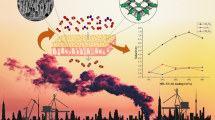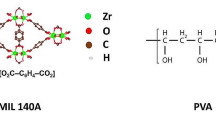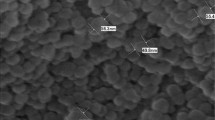Abstract
This study focuses first on the preparation of mixed matrix supported membranes of polyvinyl alcohol (PVA) and low-hydroxylated fullerenol C60(OH)12 used to create water selective membranes and then on their pervaporation properties for the separation of water-THF mixtures. These novel supported PVA membranes containing nano-carbon particles were prepared to reach high membrane performance for further integration in a dehydration process, such as distillation coupled to pervaporation. The separation of water-THF mixtures was performed with the supported membranes over a wide range of water concentrations in the feed mixture, i.e., from the azeotrope range up to 30 wt%, to evaluate the performance and stability of the thin active layer. SEM was used to visualize the internal morphology of the membrane. The influence of temperature on the transport properties was also investigated. All the membranes were highly water selective and stable up to 30 wt% water in the feed. The best compromise of transport properties was obtained for the C60(OH)12(5%)-PVA supported composite membrane: a permeate enrichment of 99.3 ± 0.3 wt% water and a flux of 0.25 ± 0.02 kg/(m2 h) for the separation of a mixture containing 5.7 wt% water and 94.3 wt% tetrahydrofuran (THF) at 30 °C. Considering its water stability, this supported membrane with a dense layer thinner than 2 μm appears promising for use in hybrid industrial processes to upgrade solvents with a smaller environmental footprint than conventional methods.









Similar content being viewed by others
References
Baker RW, Wijmans JG, Huang Y (2010) Permeability, permeance and selectivity: a preferred way of reporting pervaporation performance data. J Memb Sci 348:346–352. doi:10.1016/j.memsci.2009.11.022
Bradley D, Williams G, Lawton M (2010) Drying of organic solvents: quantitative evaluation of the efficiency of several desiccants. J Org Chem 75:8351–8354. doi:10.1021/jo101589h
Chapman PD, Oliveira T, Livingston AG, Li K (2008) Membranes for the dehydration of solvents by pervaporation. J Memb Sci 318:5–37. doi:10.1016/j.memsci.2008.02.061
Koczka K, Manczinger J, Mizsey P, Fonyo Z (2007) Novel hybrid separation processes based on pervaporation for THF recovery. Chem Eng Process 46:239–246. doi:10.1016/j.cep.2006.05.016
Mahdi T, Ahmad A, Nasef MM, Ripin A (2015) State-of-the-art technologies for separation of azeotropic mixtures. Sep Purif Rev 44:308–330. doi:10.1080/15422119.2014.963607
Penkova A V, Acquah SFA, Dmitrenko ME, et al (2016) Improvement of pervaporation PVA membranes by the controlled incorporation of fullerenol nanoparticles. Mater Des 96:416–423. doi: 10.1016/j.matdes.2016.02.046
Penkova AV, Acquah SFA, Sokolova MP et al (2015) Polyvinyl alcohol membranes modified by low-hydroxylated fullerenol C-60(OH)12. J Memb Sci 491:22–27. doi:10.1016/j.memsci.2015.05.011
Penkova AV, Acquah SFA, Dmitrenko ME et al (2014) Transport properties of cross-linked fullerenol-PVA membranes. Carbon N Y 76:446–450. doi:10.1016/j.carbon.2014.04.053
Rao KSVK, Subha MCS, Sairam M et al (2007) Blend membranes of chitosan and poly(vinyl alcohol) in pervaporation dehydration of isopropanol and tetrahydrofuran. J Appl Polym Sci 103:1918–1926. doi:10.1002/app.25078
Sajjan AM, Jeevan Kumar BK, Kittur AA, Kariduraganavar MY (2013a) Development of novel grafted hybrid PVA membranes using glycidyltrimethylammonium chloride for pervaporation separation of water–isopropanol mixtures. J Ind Eng Chem 19:427–437. doi:10.1016/j.jiec.2012.08.032
Sajjan AM, Kumar BKJ, Kittur AA, Kariduraganavar MY (2013b) Development of novel grafted hybrid PVA membranes using glycidyltrimethylammonium chloride for pervaporation separation of water-isopropanol mixtures. J Ind Eng Chem 19:427–437. doi:10.1016/j.jiec.2012.08.032
Servel C, Roizard D, Favre E, Horbez D (2014) Improved energy efficiency of a hybrid pervaporation/distillation process for acetic acid production: identification of target membrane performances by simulation. Ind Eng Chem Res 53:7768–7779. doi:10.1021/ie500467k
Truong HT, Rode S, Roizard D et al (2013) Dehydration of reactive industrial mixtures by pervaporation: an innovative approach in acrylic esters processes. Sep Purif Technol 120:24–34. doi:10.1016/j.seppur.2013.09.017
Wilkes PR, Scarlett J, Harrison GE (1990) Process for the purification of tetrahydrofuran.
Xu S, Wang H (2006) A new entrainer for separation of tetrahydrofuran-water azeotropic mixture by extractive distillation. Chem Eng Process 45:954–958. doi:10.1016/j.cep.2006.02.001
Acknowledgements
A.V. Penkova would like to thank the Fellowship of the President of Russia СП-1153.2015.1. The authors would also like to gratefully acknowledge the grants of the Russian Foundation for Basic Research No. 15-58-04034, the grants of St. Petersburg State University (No. 12.42.1003.2016) (M.E. Dmitrenko), and the financial support from Région Lorraine (ARCUS 3). This research was partially supported by a grant from the Russian Foundation for Basic Research No. 15-03-02131. The experimental work of this study was facilitated by equipment from the Resource Centers of GEOMODEL, the Chemical Analysis and Materials Research Centre, and the Interdisciplinary Resource Center for Nano Technology at St. Petersburg State University. The authors would also like to gratefully acknowledge Etienne Berger for her help with the Aspen calculations.
Author information
Authors and Affiliations
Corresponding author
Additional information
Responsible editor: Santiago V. Luis
Rights and permissions
About this article
Cite this article
Penkova, A.V., Dmitrenko, M.E., Ermakov, S.S. et al. Novel green PVA-fullerenol mixed matrix supported membranes for separating water-THF mixtures by pervaporation. Environ Sci Pollut Res 25, 20354–20362 (2018). https://doi.org/10.1007/s11356-017-9063-9
Received:
Accepted:
Published:
Issue Date:
DOI: https://doi.org/10.1007/s11356-017-9063-9




